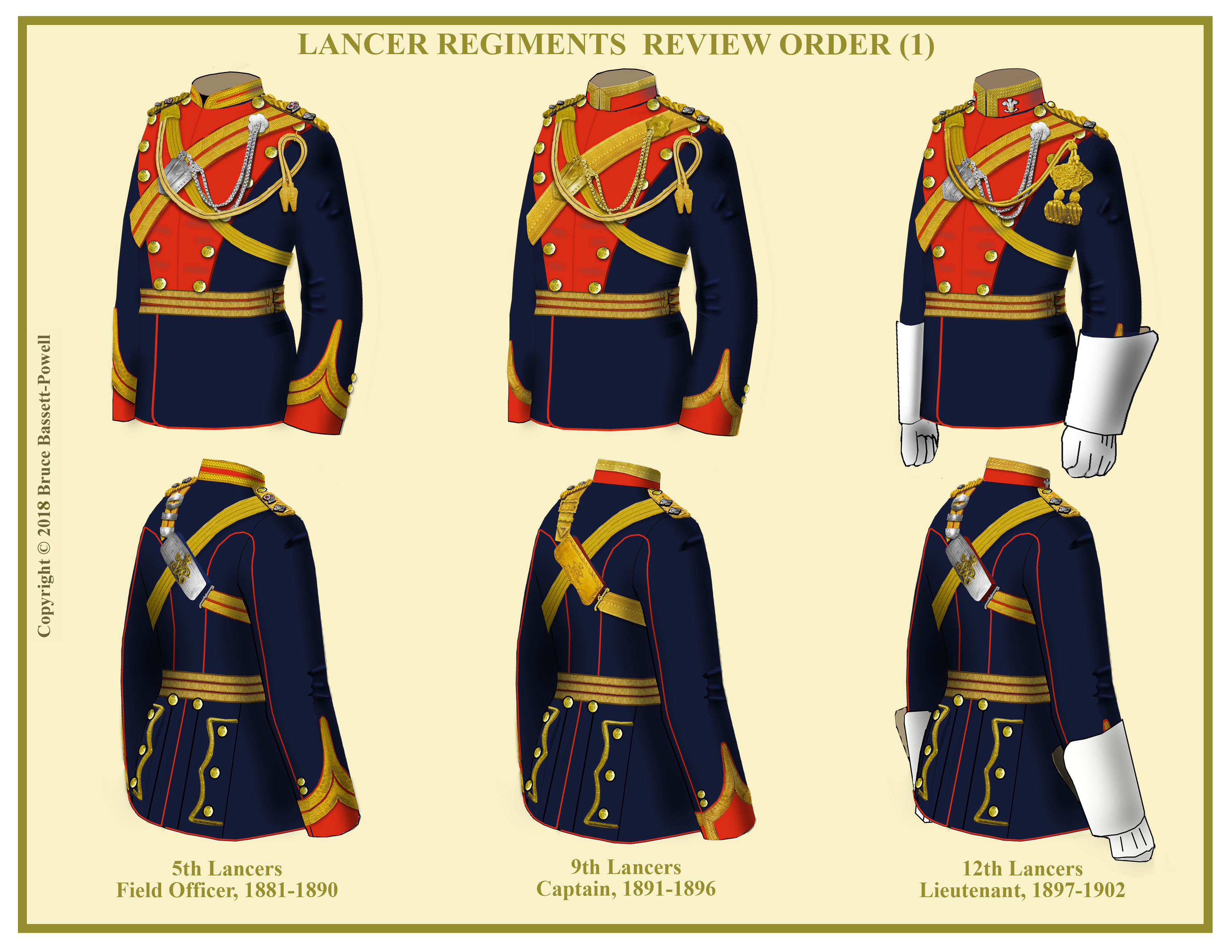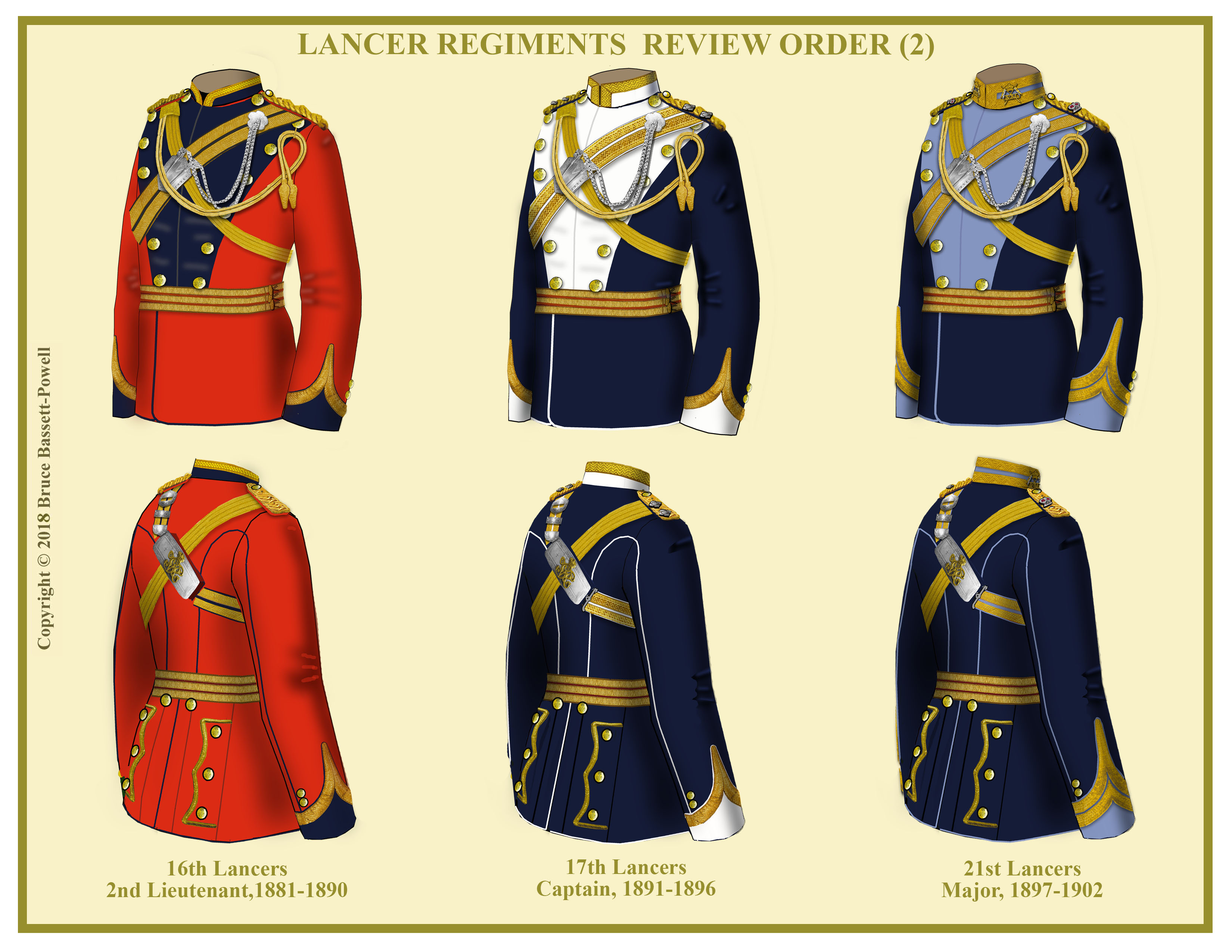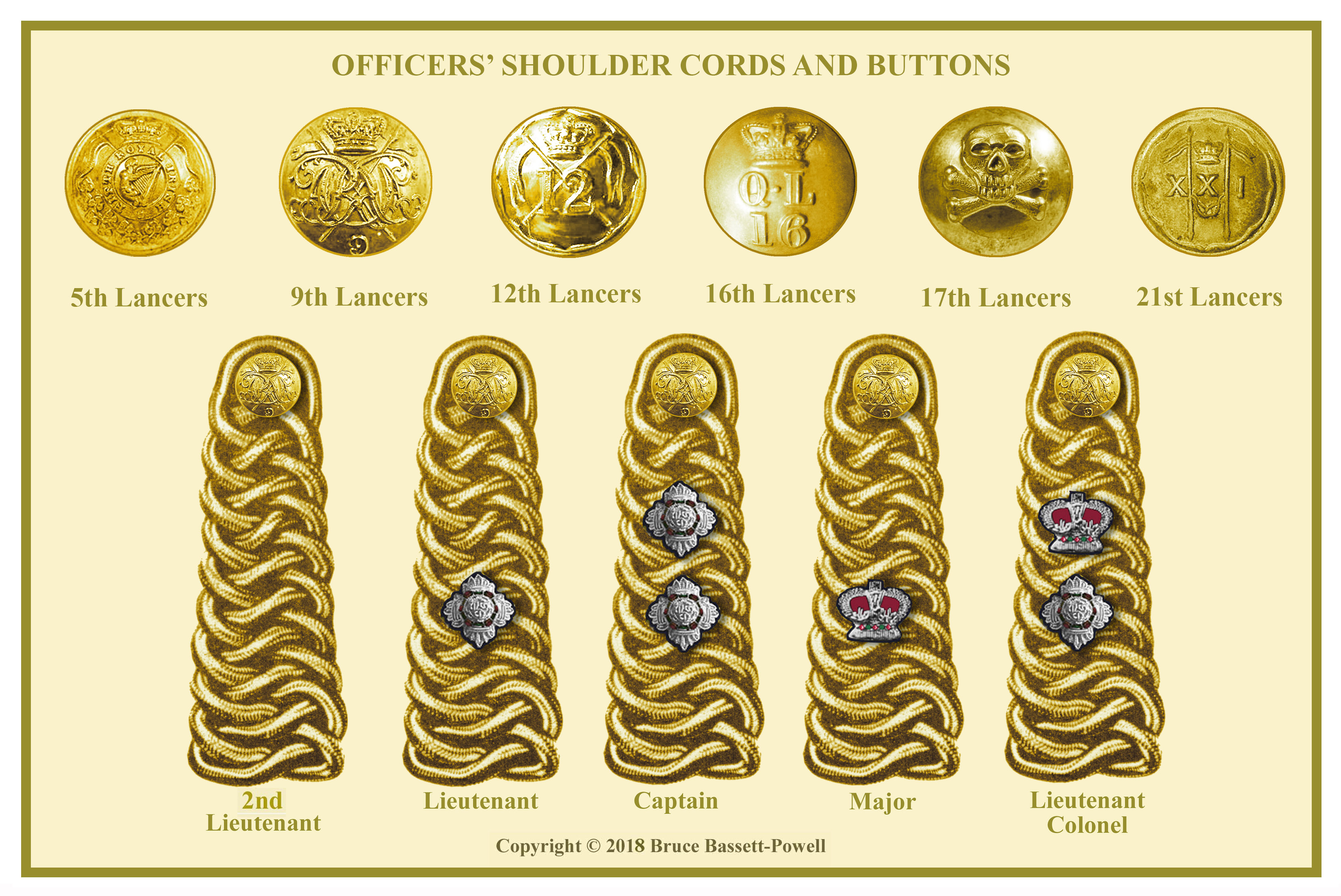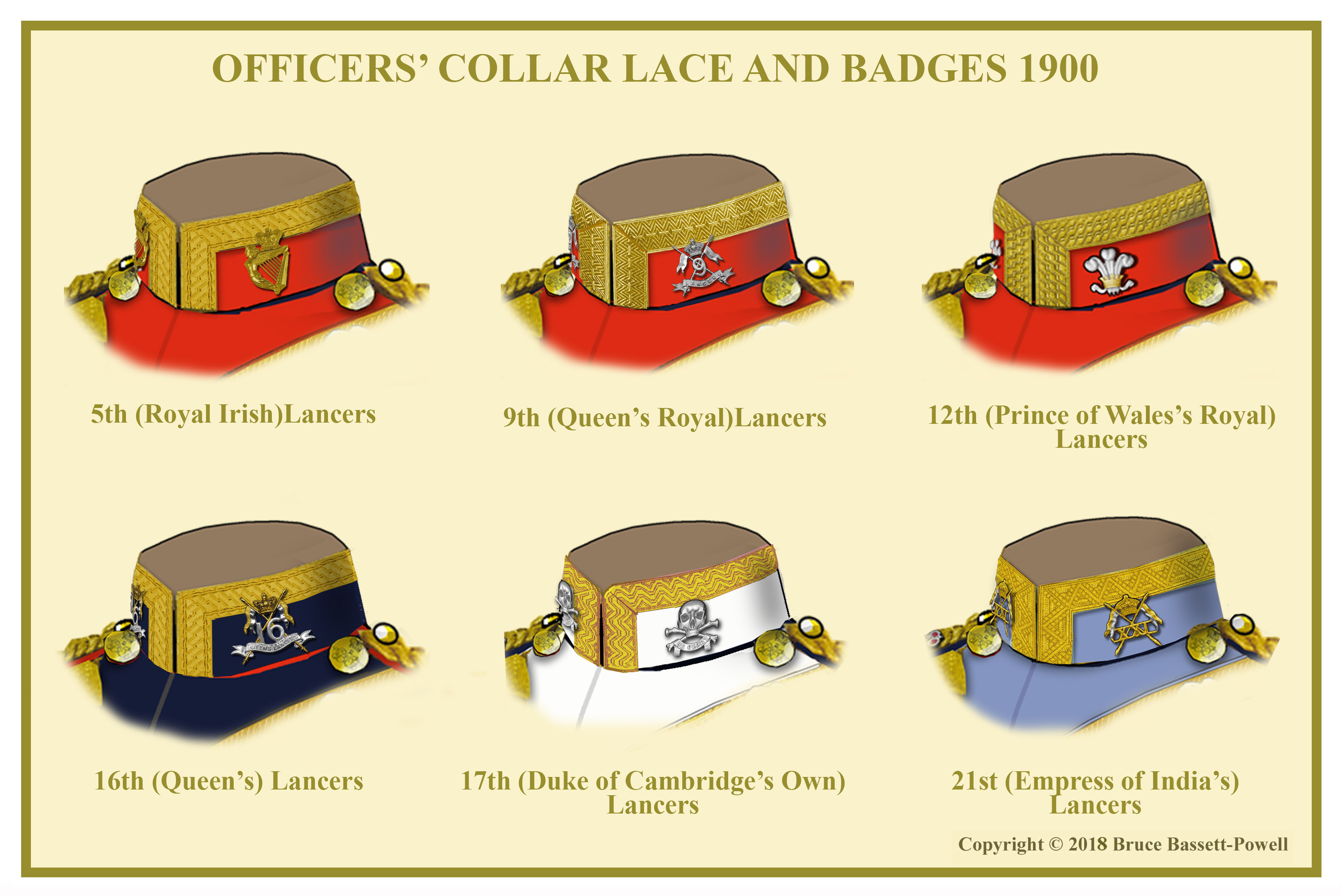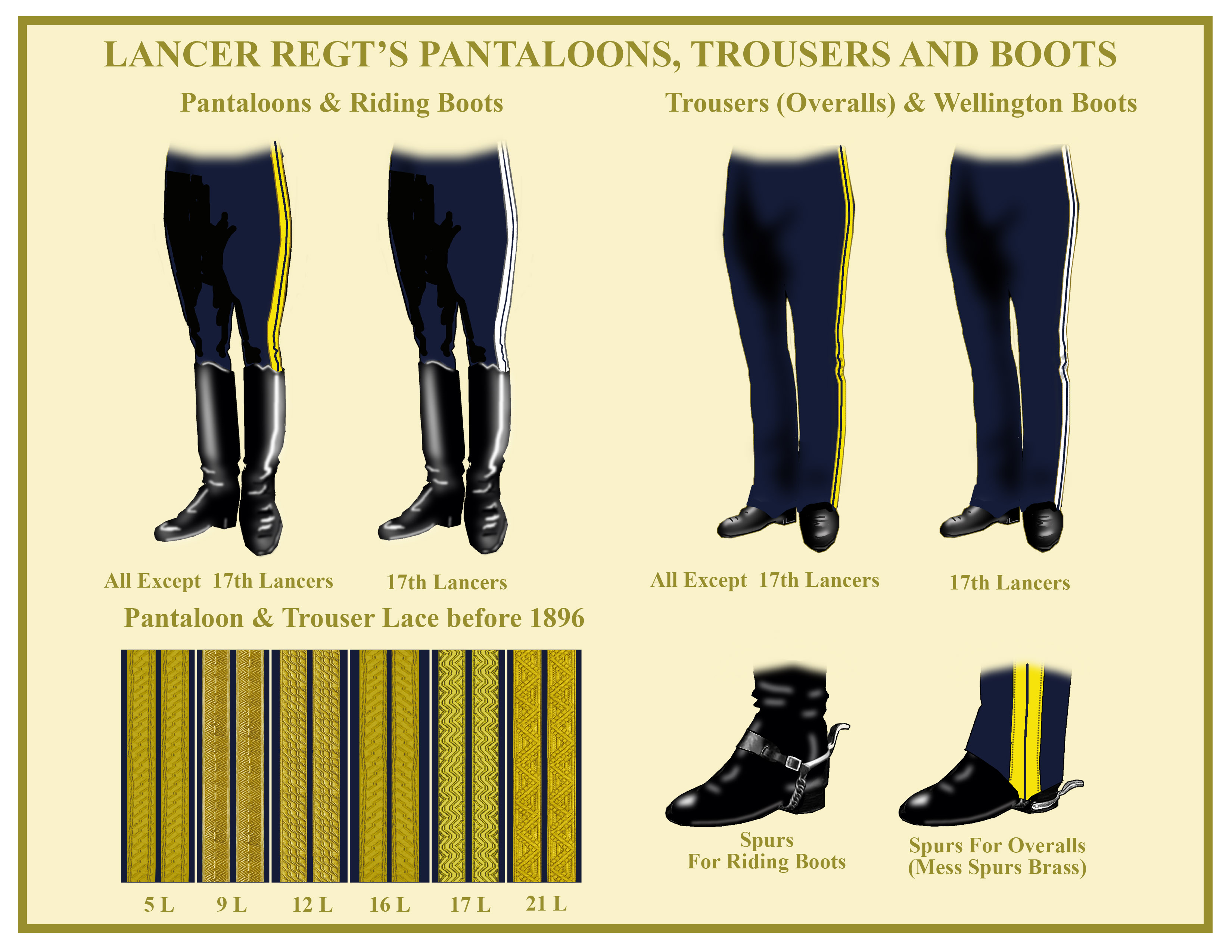UNIFORMS, ARMS & EQUIPMENT - LANCERS
LANCER UNIFORMS 1881-1902
FULL DRESS TUNICS
In 1881 the tunics of Lancer officers was virtually unchanged from 1874. The collar, cuffs, lapels and piping were of facing colour and for the six regiments existing in1902, the distinctions were as follows.
The 5th (Royal Irish) Lancers. Tunic Dark Blue, Facings Scarlet
The 9th (Queen’s Royal) Lancers. Tunic Dark Blue, Facings Scarlet
The 12th (Prince of Wales’s Royal) Lancers. Tunic Dark Blue, Facings Scarlet
The 16th (Queen’s) Lancers. Tunic Scarlet, Facings Dark Blue
The 17th (Duke of Cambridge’s) Lancers. Tunic Dark Blue, Facings White
The 21st (Empress of India’s) Lancers. Tunic Dark Blue, Facings French Grey
In the 1883 and 1891 Dress Regulations describe the tunic front (sometimes called the Plastron) was to be buttoned back (Showing the facing colour) but allowing for it to be buttoned over on the march or in inclement weather. There is little photographic evidence of officers buttoning lapels over after 1881 although the 17th Lancers may have during the Zulu War. (There are photos of other ranks doing so). In the 1900 regulations there was no mention of it. The tunic had two rows of buttons, seven on each side including one by the collar which were 8 inches apart at the top and 4 at the waist. A flat button on each side was under the girdle. For Captains and Lieutenants, the collar was edged with one inch lace of regimental pattern on the top and front and on the pointed cuffs extending to 8 ½ inches at the top. For field officers there was an additional row on the bottom edge of the collar and two above the pointed cuffs. The piping in facing colour went down the back seams and sleeves of the tunic and around the skirts. The skirts had a three pointed flap on the back edged with gold cord with three buttons on the flap and two at the waist. The shoulder cords were of bright gold wire lined with scarlet in the 16th Lancers and blue in the other regiments.
The girdle for all regiments was gold lace 2 ½ ins wide with two crimson silk stripes and fastened on the left inside with a buckle and loop and the outside with 3 gold gimp cords attached to gold olivets.
Although described with the lancer cap, the gold cord cap lines were actually separate and part of the full dress tunic. The four joined lines were looped around the body passing under the left shoulder cords. A narrow gold lace sleeve was attached around the lines under the shoulder cords to allow the two lines attached to the cap to pass through and loop up to the left side attached to the top button with a thin gold cord, the olive ends hanging down. For review order and Levees only, The 12th Lancers had the “Flounder” type of ends to the cap lines. These were worn by all regiments before 1855.
The gold lace shoulder belt and pouch (described in the next section) was worn over the left shoulder over the cap lines around the body.
BUTTONS
The buttons were listed as “Regimental pattern” in the dress regulations before 1900 when they were described in detail. Original examples seem to show that there was little or no variation between 1881 and 1900 (except with 21st Lancers). The 1900 descriptions are as follows:
The 5th (Royal Irish) Lancers.
On crossed lances a circle surmounted by a crown, with a shamrock wreath below. On the circle “Fifth Royal Lancers”. Within the circle, the Harp.
The 9th (Queen’s Royal) Lancers.
On crossed lances a circle surmounted by a crown, the letters “AR” reversed and intertwined. Below the letters the figure “9”.
The 12th (Prince of Wales’s Royal) Lancers.
Scalloped edge; “12” resting on crossed lances surmounted by a crown.
The 16th (Queen’s) Lancers.
A crown with “QL” below and above the figure “16”.
The 17th (Duke of Cambridge’s) Lancers.
Full domed gilt burnished with the Death’s Head.
The 21st (Empress of India’s) Lancers.
Scalloped edge. Between the numerals “XXL”. A pair of upright lances. Between the pennons, a crown.
COLLAR BADGES 1900
Like the rest of the cavalry, lancer regiments were authorised to wear collar badges in 1896/7. For the first five regiments, they remained unchanged until 1902.
The 5th (Royal Irish) Lancers.
The Harp and crown in gilt or gilding metal.
The 9th (Queen’s Royal) Lancers.
In silver the figure “9” on crossed lances. Above, a crown. Below the “9” a scroll inscribed “Lancers”.
The 12th (Prince of Wales’s Royal) Lancers.
The Prince of Wales’s plume, the plume and motto in silver, the coronet in gilt or gilding metal.
The 16th (Queen’s) Lancers.
In silver, the figure “16” and a scroll below inscribed “Queen’s Lancers” on a pair of crossed lances. Between the pennons, a crown; the lower part of the pennons in silver; the remainder of the lances and the crown in gilt or gilding metal.
The 17th (Duke of Cambridge’s) Lancers.
In silver, the Death’s Head and scroll, inscribed with “or Glory”.
The 21st (Empress of India’s) Lancers.
In gilt or gilding metal, a pair of crossed lances; between the pennons a crown. Upon the staves “XXL”. The lower part of the pennons in silver. In 1901 another pattern was authorised with upright lances with XXI between the shafts.
PANTALOONS, TROUSERS & FOOTWEAR
In mounted review order, officers wore pantaloons of blue cloth for all regiments. These were flared in the thigh and tight below the knee. 1n 1881 double ¾ inch stripe of gold regimental lace was worn down each side. In 1890 gold lace stripes were abolished for all regiments and yellow lace (like the other ranks) was ordered to be worn on mounted duties. In the 17th Lancers the stripes were white. These pantaloons tucked into black leather knee boots with a “V” cut in front. Crane neck steel spurs with straps & buckles were worn.
In dismounted review order, trousers were worn with the same gold lace down the sides as on the pantaloons. By 1890 the gold laced trousers were reserved for levées and special occasions only. Trousers with yellow stripes (white in the 17th Lancers) were worn in review order from then on. Trousers were worn with Wellington boots with boxed spurs. In mess dress brass spurs were worn except by the 17th who maintained steel.
GLOVES
White leather gauntlets were worn in both mounted and dismounted review order. (See 12th Lancers in image below)



